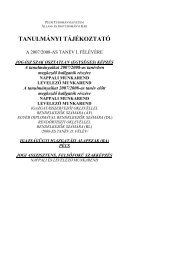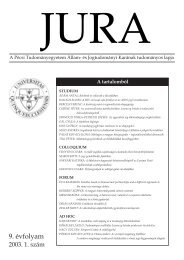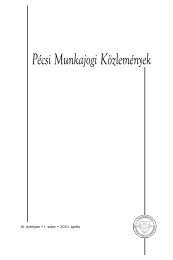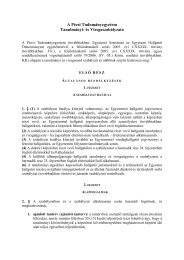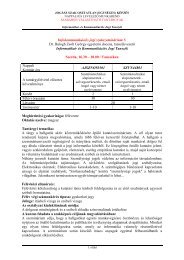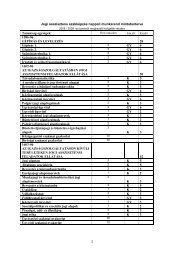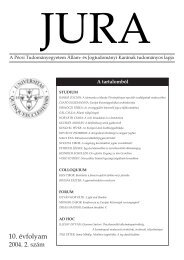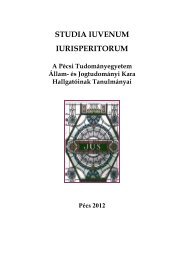2012. évi 2. szám - Jura - Pécsi Tudományegyetem
2012. évi 2. szám - Jura - Pécsi Tudományegyetem
2012. évi 2. szám - Jura - Pécsi Tudományegyetem
- TAGS
- jura
You also want an ePaper? Increase the reach of your titles
YUMPU automatically turns print PDFs into web optimized ePapers that Google loves.
Andityas Soares de Moura Costa Matos: An alternative approach to the basic norm …141the only interpretation which is consistent with Kelsen’sfirm resistance to revise the second edition ofthe “Pure Theory of Law”. This attitude is not dueto the fact that he was teaching an old and finisheddoctrine, but because of the author’s conviction thathis contribution had been exhausted with the finalversion of the “Pure Theory of Law”, publishedexactly 50 years ago, in 1960, when the “skepticalphase” of Kelsen’s thought began, according to thetimeline proposed by Paulson. 3 To note Kelsen’sdisposition not to modify his major work, we cancheck the preface of the “Pure Theory of Law”. Thedevelopment of the book ended right there to Kelsen,leaving to his disciples the task to continue his work.And as we know, in this second and final edition, thebasic norm is described as a transcendental-logicalhypothesis.3.2 Transcendental-logical hypothesis3.<strong>2.</strong>1 Cohen’s influenceSince the basic norm cannot be self-evident (Kelsen1997, 218), Kelsen conceives it as a logical-transcendentalhypothesis in the sense of Kant’s criticalphilosophy, as reinterpreted by Hermann Cohen(1842-1918), who is one of the founders and animportant member of the School of Marburg, whohad among his disciples proeminent jurists such as,for instance, Ernst Cassirer. Kelsen believes that allneo-Kantian attempts to establish a specifically legalcognition have failed. Only his major work, “PureTheory of Law”, was successful in this task (Hammer2007, 182-183), which is why Kelsen is not a mereimitator of the great thinkers of Marburg and Heidelberg.4 Moreover, it seems important to emphasizethat Kelsen only takes up Cohen’s epistemologicalreflection, since his practical philosophy – as, indeed,that of Kelsen himself – was trapped in metaphysics(Edel 2007, 204). Hence, the merits and originalityof Kelsen to propose an application for the criticalprinciples of Kant and Cohen to a subject which, untilthen, only had been thought in non-scientific terms,even by these two philosophers. Acknowledging hisdebt in 1923 to Cohen – especially to his “Ethics ofPure Will” –, Kelsen admits having learned from himthat the epistemological orientation creates its ownobject, generating it logically from a certain origin(Ursprung), exactly like the innovative proposal of thebasic norm (Kelsen 2007a, 15). 5 However, althoughKelsen’s theory presents great originality, it is undeniableits connection with the doctrine of Cohen,which we began to expose in a synthetic way.The theory of the hypothesis created by Cohenand subsequently used by Kelsen for the developmentof the Grundnorm can be seen as an attemptto overcome the psychologism found in Kant’s“Critique of Pure Reason”. According to Cohen,philosophy boils down to epistemology, because itsobject is not the material world, but the cognition ofthis world (Edel 2007, 204). Therefore, Cohen believesthat all scientific knowledge should be based inepistemological legitimization. This thesis was fullyaccepted by Kelsen since 1912, when he entertains thefirst contacts with the system developed by Cohen(Kelsen 2007a, 15).According to Cohen, to make all knowledge dependon the pure intuitions of space and time andto found the dichotomy that separates the unknowablething (noumenon) and the one perceived by thesubject (phenomenon), Kant would have deniedthe possibility of any objective cognition of reality.It is against these conclusions that Cohen’s theoriesare developed. Beyond the intuitions of space, timeand the whole cognitive apparatus described byKant – that would be objects of psychology andneuroscience, never philosophy –, Cohen yearns todemonstrate how it is possible to validate objectivelyscientific judgments (Edel 2007, 205-206). For that,he uses the concept of platonic hypothesis, whichhas nothing to do with the modern notion accordingto which a hypothesis would be a kind of truth(prior and provisional) to be tested and validated byexperimentation in the empiric field. For Plato andCohen, scientific hypotheses are immune to empiricaltesting, reflecting, as definitions and the mathematicalaxioms do, certain assumptions necessary for anysubsequent judgment.Nonetheless, unlike Plato, Cohen argues thatsuch hypotheses do not have a metaphysical nature,since they are always subject to changes. They arenot, therefore unconditional assumptions, but ratherresults of the thought that serves as the foundationfor scientific cognition (Edel 2007, 208). Characteristically,when questioned about what establishes orturns the highest scientific principle possible, Cohensays: nothing but itself. By definition, there can beno higher authority than the highest principle (Edel2007, 215). Kelsen uses the same argument to explainthe nature of the basic norm, a theme that to whichI will return later in this essay, when I explain myproposal to understand the Grundnorm as a scientificpostulate.3.<strong>2.</strong>2 Kant and KelsenIn conceiving the basic norm as a logical-transcendentalhypothesis, Kelsen attacks both natural lawand uncritical legal positivism (Leser 1982, 100), sincethe transcendental cognition doesn’t deal with objectsbut with the way we know them. To understand Kel-JURA 2012/<strong>2.</strong>



